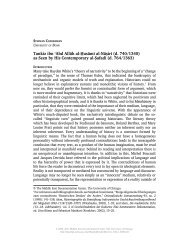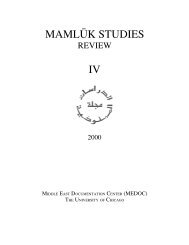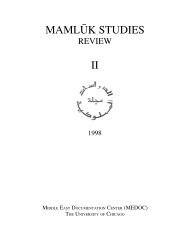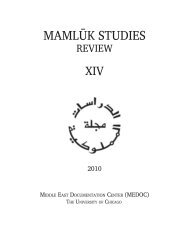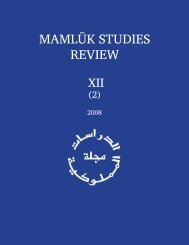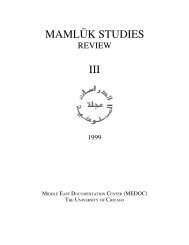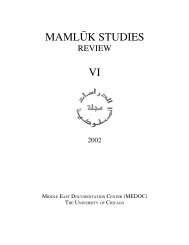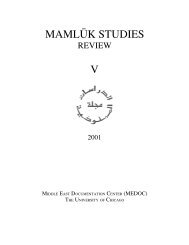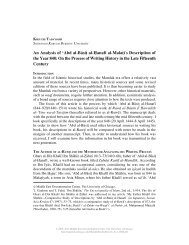Vol. VIII, no. 2 (2004) - Mamluk Studies Review - University of Chicago
Vol. VIII, no. 2 (2004) - Mamluk Studies Review - University of Chicago
Vol. VIII, no. 2 (2004) - Mamluk Studies Review - University of Chicago
Create successful ePaper yourself
Turn your PDF publications into a flip-book with our unique Google optimized e-Paper software.
44 BENJAMIN ARBEL, VENICE'S TRADE WITH THE MAMLUKS<br />
(tiber) that reached Alexandria from Tripoli on board Venetian galleys. 27 These<br />
distinctions are <strong>no</strong>t reflected in the cargo lists <strong>of</strong> our diarists, who preferred to<br />
express the overall value <strong>of</strong> precious metals sent on board these ships in terms <strong>of</strong><br />
Venetian ducats. This does <strong>no</strong>t mean, however, that the entire sum referred to<br />
consisted <strong>of</strong> gold ducats. In fact, silver ingots and coins are never mentioned<br />
separately in the cargo lists, although we k<strong>no</strong>w for certain that they were shipped<br />
to <strong>Mamluk</strong> territories in great quantities. 28 The Venetian mint even issued special<br />
silver coins for exportation to the Levant, worth less than the standard silver coins<br />
circulating in Venice. 29 In a commercial letter sent from Famagusta to Venice in<br />
1511 it was reported that the galleys sailing that year to the Levant were carrying<br />
silver coins to the value <strong>of</strong> 100,000 ducats. 30 And at the beginning <strong>of</strong> the sixteenth<br />
century, a French observer <strong>no</strong>ted that in the Venetian mint, silver ingots weighing<br />
about 25 marks each (some 6 kg.), were especially produced for exportation to the<br />
Levant, to a total annual amount equivalent <strong>of</strong> about 800,000 ducats. 31 A great part<br />
<strong>of</strong> those must have reached <strong>Mamluk</strong> territories.<br />
Though <strong>no</strong>t bothering to distinguish between gold and silver, our diarists do,<br />
however, use other distinctions that can<strong>no</strong>t be easily understood. For example,<br />
with reference to the Beirut galleys <strong>of</strong> November 1502 and to the Alexandria<br />
galleys <strong>of</strong> March 1503 and <strong>of</strong> March 1511, Priuli distinguishes between what he<br />
calls aver di cassa a <strong>no</strong>llo or al <strong>no</strong>lo, and aver di cassa di marcadanti; Sanudo, on<br />
the other hand, uses different distinctions in 1501 and 1511, referring to aver di<br />
cassa d'aviso and aver di cassa in scrigni. 32 These distinctions may partly be<br />
understood if we consider that cash money or silver ingots transported on the<br />
27<br />
See Appendix B-I.<br />
28<br />
For overall estimations <strong>of</strong> precious metals shipped to Egypt and Syria during the period under<br />
examination, see Appendix C. For silver, see Ashtor, Les métaux précieux, 50; and Frederic C.<br />
Lane, Venice, A Maritime Republic, 287, 299. E.g.: expressing his dissatisfaction with the fact that<br />
Venetians unloaded their ships at Tripoli instead <strong>of</strong> Beirut in 1499, the gover<strong>no</strong>r <strong>of</strong> Damascus<br />
seized 52 sachets (groppi) <strong>of</strong> silver coins kept by Venetian merchants (Malipiero, "Annali," 649);<br />
see also the list <strong>of</strong> coins sent in 1505 by Michiel da Lezze on board the Barbary galleys, where the<br />
value <strong>of</strong> each coin sachet is expressed in ducats, specifying at the same time that they actually<br />
contained silver coins (Mozenigi) (Braudel and Tenenti, "Michiel da Lezze," 57).<br />
29<br />
Sanudo mentions a decision taken in March 1498 by the Council <strong>of</strong> Ten in this regard: Sanudo, I<br />
diarii, 1:903.<br />
30<br />
Ugo Tucci, "Monete e banche nel secolo del ducato d'oro," in Storia di Venezia dalle origini alla<br />
caduta della Serenissima, vol. 5, Il Rinascimento: Società ed eco<strong>no</strong>mia, ed. Alberto Tenenti and<br />
Ugo Tucci (Rome, 1996), 785.<br />
31<br />
Frederic C. Lane and Reinhold C. Mueller, Money and Banking in Medieval and Renaissance<br />
Venice, vol. 1, Coins and Moneys <strong>of</strong> Account (Baltimore and London, 1985), 165.<br />
32<br />
See Appendix A.<br />
© <strong>2004</strong>, 2012 Middle East Documentation Center, The <strong>University</strong> <strong>of</strong> <strong>Chicago</strong>.<br />
http://mamluk.uchicago.edu/<strong>Mamluk</strong><strong>Studies</strong><strong>Review</strong>_<strong>VIII</strong>-2_<strong>2004</strong>.pdf



